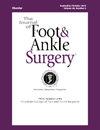Ankle fractures reduction under direct visualization. Superiority of anatomical landmarks versus radiological evaluation- A randomised control trial
IF 1.3
4区 医学
Q2 Medicine
引用次数: 0
Abstract
Distal tibiofibular joint injury is quite common in rotational ankle fractures, with high malreduction rates reported. Although several intraoperative techniques evaluate the optimal tibiofibular reduction, they are critically debated due to high error rates and subjective interpretation of the results. We attempted to describe specific anatomical landmarks and anatomical relationships of the ankle joint through capsulotomy and inspection of the anterior incisura fibularis corner and evaluate their reliability regarding optimal tibiofibular reduction. Sixty patients with malleolar fractures and concomitant distal tibiofibular joint disruption were randomized into two groups. Patients of Group A were treated with a standard approach. In Group B, the reduction was performed following specific anatomical landmarks of the anterolateral ankle joint through capsulotomy. Reduction quality was evaluated with postoperative bilateral ankle CT. Distal tibiofibular joint reduction after direct visualization resulted in significantly better rotation and fibula length values than patients treated with the standard approach. In addition, clinical scores were better in the 3rd and 6th postoperative months.
Direct visualization of the anterolateral ankle joint can provide trustworthy anatomical landmarks to achieve high-quality reduction of the distal tibiofibular joint in ankle fractures. Additional repair of the ligamentocapsular structures of the corner enhances joint stability and provides better clinical outcomes in 12 months.
直接目视下复位踝关节骨折。解剖标志与放射学评价的优越性——一项随机对照试验。
远端胫腓骨关节损伤在踝关节旋转骨折中很常见,据报道复位不良率很高。虽然有几种术中技术评估最佳的胫腓骨复位,但由于高错误率和对结果的主观解释,它们受到了激烈的争论。我们试图通过囊膜切开术和检查前腓骨切牙角来描述踝关节的特定解剖标志和解剖关系,并评估其关于最佳胫腓骨复位的可靠性。60例踝部骨折合并胫腓骨远端关节断裂患者随机分为两组。A组患者采用标准方法治疗。在B组,通过囊腔切开术根据踝关节前外侧的特定解剖标志进行复位。术后双侧踝关节CT评价复位质量。直接目视复位远端胫腓骨关节后的旋转和腓骨长度值明显优于采用标准入路治疗的患者。术后第3、6个月临床评分较高。踝关节前外侧关节的直接可视化可以提供可靠的解剖标志,以实现高质量的远端胫腓骨关节复位。关节角韧带囊结构的额外修复增强了关节的稳定性,并在12个月内提供了更好的临床结果。
本文章由计算机程序翻译,如有差异,请以英文原文为准。
求助全文
约1分钟内获得全文
求助全文
来源期刊

Journal of Foot & Ankle Surgery
ORTHOPEDICS-SURGERY
CiteScore
2.30
自引率
7.70%
发文量
234
审稿时长
29.8 weeks
期刊介绍:
The Journal of Foot & Ankle Surgery is the leading source for original, clinically-focused articles on the surgical and medical management of the foot and ankle. Each bi-monthly, peer-reviewed issue addresses relevant topics to the profession, such as: adult reconstruction of the forefoot; adult reconstruction of the hindfoot and ankle; diabetes; medicine/rheumatology; pediatrics; research; sports medicine; trauma; and tumors.
 求助内容:
求助内容: 应助结果提醒方式:
应助结果提醒方式:


